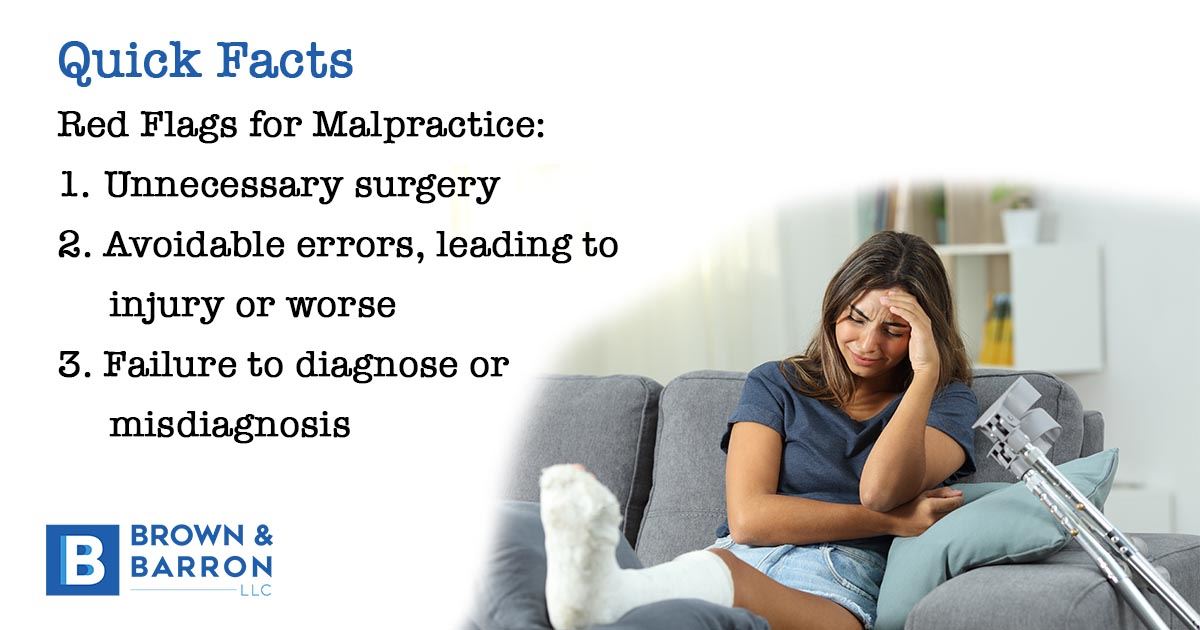Quick Facts
- When to Suspect Podiatry Malpractice in Maryland:
- Unnecessary surgery, when other, less invasive methods should have been tried first.
- Complications when the standard of care is not met, leading to avoidable injury or worse.
- Misdiagnosis, including a failure to test or correctly identify conditions, leading to injury or worse.
To schedule a free case review with a podiatrist malpractice lawyer serving Baltimore, call Brown & Barron at (410) 698-1717 or contact us online today!
A podiatrist, also called a foot doctor, is an expert on identifying and healing ailments of the feet. We never truly appreciate our feet (or the podiatrist) until we have a painful problem with our ankle, heel, foot, or toes. Like any medical practice, there are multiple ways in which the care given by a podiatrist can qualify as malpractice. Some podiatry errors are more common than others.
Here are the three main types of podiatry malpractice:
Unnecessary surgery
Many people have painful issues with their ankles, feet, or toes that have gotten progressively worse over time and nagged them for years before they seek help. Some of the most common issues include bunions, plantar fasciitis, hammertoes, and other common ailments. Podiatrists are the experts in providing a course of relief from these painful and debilitating issues.
The reality is that there are 26 bones in each ankle/foot with 33 joints connecting them. Any one of these bones, joints, tendons, ligaments, or cartilage can cause pain, which can make it difficult to engage in sports, physical activity, or even make it hard to get around.
In many of these cases, relief can be achieved with non-surgical solutions, including rest, ice, physical therapy, pain management medications, a change of footwear, custom orthotics, or splints. When those solutions fail, or the condition is too severe for non-invasive methods, a surgical intervention might be necessary. The surgical solution can involve joint replacement with a prosthetic, a fusing of bones to remove a problematic joint, steroid injections, or other surgical methods.

In some situations, a surgical method is prematurely performed, when other less invasive methods should have been tried first. Other times, the patient is not informed of the risks and non-invasive alternatives, information that must be communicated from the podiatrist as a patient right. With most surgeries, there are inherent risks, so it is best to exhaust any lower-risk non-surgical interventions if they have been known to offer positive results in similar situations. At the very least, the patient should know the potential risks, the alternatives, and the likelihood of success based on existing studies.
The risk of surgery can sometimes result in a second or even multiple corrective surgeries to achieve the desired result, leading to months of disability and painful recovery. In some situations, the worst-case outcome occurs, which can mean a permanent loss of function. Imagine losing the ability to walk because you wanted to correct a mildly painful toe.
If you want more articles like this, subscribe to our free monthly newsletter by clicking here.
Complications from improperly performed surgery
As with any surgery, there is some amount of risk, which must be evaluated by the podiatrist and communicated clearly to the patient. According to Orthopedic Reviews, the lawsuits against podiatrists “primarily occurred over elective procedures (94.5%) and most frequently involved plaintiff complaints of persistent pain (41.8%) or deformation (27.3%). Podiatrist cases most often involved allegations of failure to treat (45.5%) or inappropriate surgical procedure (27.3%).” It’s important to note that many podiatry surgeries are elective surgeries to improve function, correct deformities, or reduce pain. When the outcomes for these elective improvements, result in worse function (or total loss of use), increased pain, or further disfigurement, it calls into question the necessity of a surgical option and whether the standard of care was met. Even when a surgery is the proper course of action, if it is not performed properly, it can result in significant complications that can be debilitating and expensive to correct.
Misdiagnosis
Many issues of the feet have similar symptoms as reported by the patient. It is the duty of the podiatrist to perform the correct evaluation and order the required tests and exams to identify the underlying issue. A failure to provide adequate care, or to refer a patient to the proper specialist, or a lack of follow up can have extreme consequences for the patient. Without the proper examination, foot pain can be misdiagnosed as a problem of being overweight, overuse from sports, or ill-fitting shoes, when a more serious problem needs to be addressed, such as diabetic foot ulcer, gout, cancer, gout, and other issues. In cases of diabetic ulcers or peripheral artery disease (PAD), improper handling of infection can have devastating outcomes, including amputation of part of the limb or the entire foot or limb.
To schedule a free case review with a podiatrist malpractice lawyer serving Baltimore, call Brown & Barron at (410) 698-1717 or contact us online today!
What Should I Do If I Suspect Podiatry Malpractice?
The vast majority of podiatry cases result in extraordinary care for the patient by talented and passionate professionals. Like all professions there are inferior practitioners, and even the competent ones are not immune to unfortunate mishaps. When errors happen due to a podiatry error or negligence, it can result in long-term disability for the patient. For the victim of a podiatry error and their families, it can mean years of expenses and economic losses that can translate into thousands if not millions of dollars. It’s only fair that those responsible for medical malpractice contribute to help the families recover those damages. At Brown & Barron, we help families who suspect the possibility of podiatry malpractice get to the truth of the matter and recover the money that they deserve to live their best life, given the circumstance, and move forward knowing justice has been served. If you would like a free, no-obligation review of your podiatry case, call us at 410-346-0206 or contact us online.


